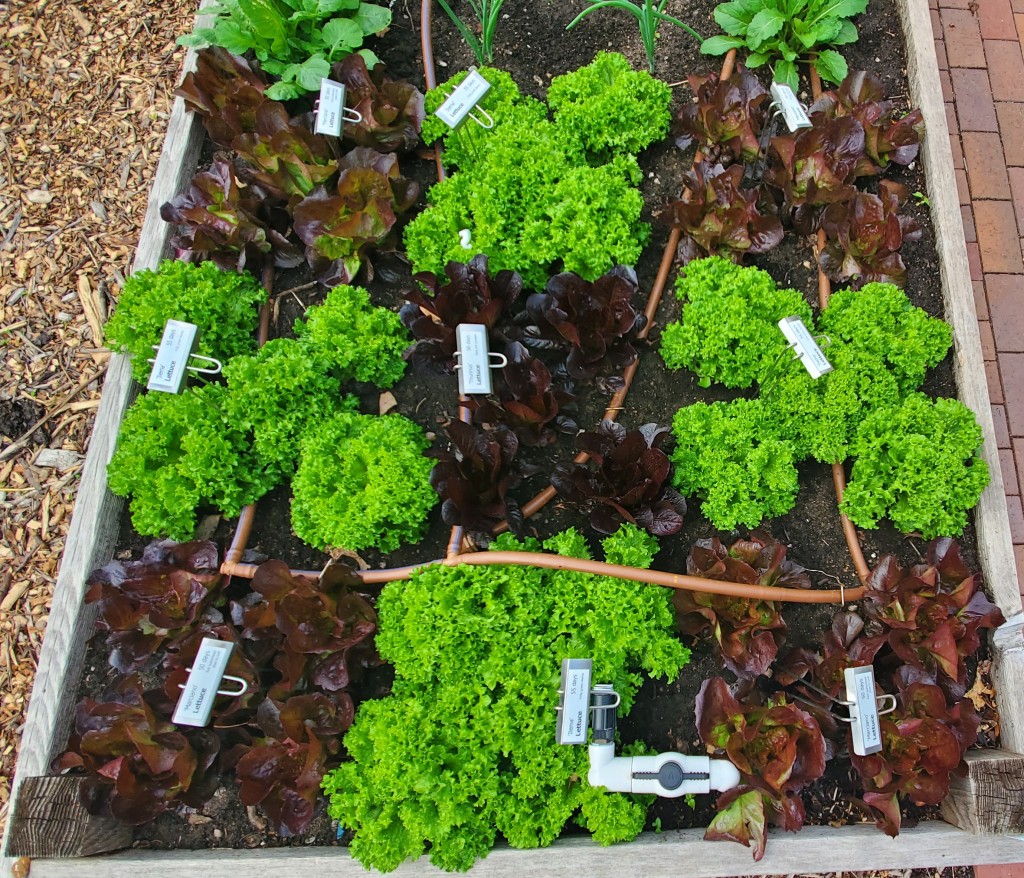A Closer Look: Bed 6 Plans & More
This is the last of our detailed bed plan posts, and because it took so long to finish this series, we even have pictures to share of what the garden looks like all planted and grown!

In this garden we are reprising something we did about 5 years ago – a “quilt block” lettuce garden. We have two quilt blocks and then some root vegetables in the center of the garden.

Nine patch quilt block – This quilt block is just squares mimicking the traditional “nine patch” quilt block pattern. We chose a dark red romaine, ‘Thurinus,’ for the center. This is a beautiful, upright variety that has performed well in the past. Then we chose a frilly green leaf lettuce, ‘Ilema,’ and a lighter red butterhead, ‘Marciano,’ for the outside squares. We started all of these lettuces indoors and then transplanted out 5 plants per square to get the pattern we wanted. They were planted a month ago, on March 29th, so it is looking spectacular right now!
The other quilt block is a star pattern, which seemed like a good idea at the time, but ended up being much more tricky to implement. We chose 4 different brassica leafy salad greens that we expected to germinate and grow at much the same rate. We opted to direct seed on the theory that it would be easier to get the right shape with the direct seeding. I also used a complicated stake and string arrangement to mark off the lines for the planting areas.

I haven’t removed the stakes and string yet, so you can kind of see the layout. The lines aren’t quite as sharp as I was hoping for with the planting, but You can get the general idea. I think that we are about ready to start thinning out the plants as they get bigger. The light green is the Tokyo Bekana. The dark green is a bok choy. The rounder purple leaves are a purple bok choy, and the frillier purple leaves are a purple mizuna. You can probably tell that the mizuna has lagged behind the others as far as growth rate, which makes the visual slighly lopsided. We also direct seeded a the same red butterhead lettuce from the other quilt block as the outer edge of the space. As you can also see, while it is growing, it really hasn’t grown at the same pace and also didn’t germinate quite as well. I do have a few extra seedlings from starting indoors that we may transplant in next week, just to round out the visual look.
Last but not least are the root veggies in the center of the bed. We chose a mini white Daikon radish, a red salad turnip, and red onions for this space.
As you can probably tell, these are all vegetables that will be completely harvested by late May or early June, depending on how quickly things get hot. So what happens next? Well, this bed has also had significant nematode challenges in past years, so once we have completed the harvest, we will be putting clear plastic over the entire bed to begin an 8-10 week solarization process. This will heat up the soil significantly and kill off the harmful nematodes. Once we have completed that, we will plant a cover crop (Sunn Hemp) that also helps to fix nitrogen and suppresses nematodes. We will probably let that grow for a few weeks and then follow up with a cool season cover crop for the fall and winter. Our hope is that this will significantly reduce nematode populations and pressure for the next growing season.
Posted on April 29, 2022, in Garden Planning. Bookmark the permalink. Leave a comment.




Leave a comment
Comments 0